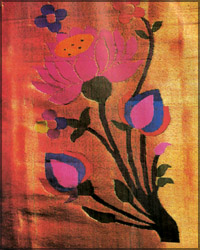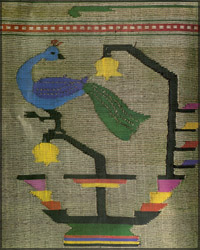Paithani Sarees
Poem in Gold :
Chitra Balasubramaniam
 The
use of gold has not been confined just to the making of ornaments in
India; its application has transcended to clothes and paintings too.
Zari, the golden thread, brings only one thing to mind the saree. And
Paithani, a fascinating dream in gold and silk, best exemplifies that. The
use of gold has not been confined just to the making of ornaments in
India; its application has transcended to clothes and paintings too.
Zari, the golden thread, brings only one thing to mind the saree. And
Paithani, a fascinating dream in gold and silk, best exemplifies that.
The Paithani saree derives its name from Paithan in the Indian state
of Maharashtra where it originated. This saree has indeed come a long
way, as its origins go back to nearly two thousand years. Ancient Greek
records contain references to the wondrous fabric from the trading
centre Pratisthan as Paithan was known in the days of yore.
Situated on the banks of the river Godavari, Pratisthan was one of
the oldest cities and a very important trading centre. From here
exquisite silk and gems were exported far and wide. It also received
tremendous patronage under the Satavahana rulers (2nd century BC).
Legend has it that the coronation of the Satavahana rulers could only be
complete after they wore the Paithani brocade.
Though the origin of this form of weaving, like many other
traditional Indian arts and crafts, is buried in the layers of history,
some historians nevertheless opine that since its weaving is similar to
the art of tapestry weaving, this technique was introduced by the
merchants trading with Pratisthan.
  The
local weavers possibly then adapted this technique and turned it into a
fine art form and created these astounding sarees. Whatever be the
origins, these were much in demand and were very well known in those
days. The kings and their edicts may no longer be in place, but this
painstaking craft exists even today to prove the timelessness of the
Indian culture. The
local weavers possibly then adapted this technique and turned it into a
fine art form and created these astounding sarees. Whatever be the
origins, these were much in demand and were very well known in those
days. The kings and their edicts may no longer be in place, but this
painstaking craft exists even today to prove the timelessness of the
Indian culture.
This art has been handed down the centuries by the patient weavers.
Their method of weaving remains the same, as it was hundreds of years
ago, and the original looms are still in use.
The gold in the old Paithani sarees used to be so pure and fine that
the shine of the saree could even mirror the face of a person. Today,
this has changed in view of the enormous costs involved, even vegetable
dyes of the yesteryears have given way to the chemical ones. What remain
unchanged however, are the patterns and the method of weaving.
Paithani saree, often described as a poem in silk and gold is very
rich and elaborately woven and quite time-consuming. The method of its
weaving is very complicated, unlike the common weaving practice, no
mechanical device like the jacquard or jalas are used. Among other
things, spindles or small tillis are used to create the designs.
 Little
bobbins are attached along the weft and multiple weft threads are
interlocked Little
bobbins are attached along the weft and multiple weft threads are
interlocked to produce the woven surface. How time consuming is the process is
described by C.R. Qureshi, a Paithani weaver from Aurangabad, who says
that a very intricate Paithani saree takes about six months to one year
to weave.
to produce the woven surface. How time consuming is the process is
described by C.R. Qureshi, a Paithani weaver from Aurangabad, who says
that a very intricate Paithani saree takes about six months to one year
to weave.
In the Benarasi brocades or Kanjeevarams the gold or silver motif is
brocaded on the silk, while in Paithani sarees the silk is brocaded on
the gold or silver borders. The fineness of the workmanship is displayed
when Qureshi shows the reverse side of the saree.
While in most other sarees the knots and other threads remain
visible, in the Paithani weave the motifs and threads bear a finished
look at the back also.
Irresistible Lure
Every woman in Maharashtra yearns to wear a Paithani saree at least
once in her lifetime. Such is the craze and lure of these exquisite
sarees. The nomenclature of these sarees is based on their colour
patterns. The two-colour sarees having shaded effect are known as Dhoop
Chhaon, the black ones are called Chandrakala, the yellow Paithanis are
Sonkala and the red are popular as Kunku.
The most difficult aspect of Paithani weaving is its nakkashi work,
which in fact determines its cost as well. Nakkashi can either be
traditional or contemporary.
Paithanis having floral motifs are called Aaswali, those with lotus
flowers are named as Lotus and the ones with peacock motifs are Saakhli
Moor. |
